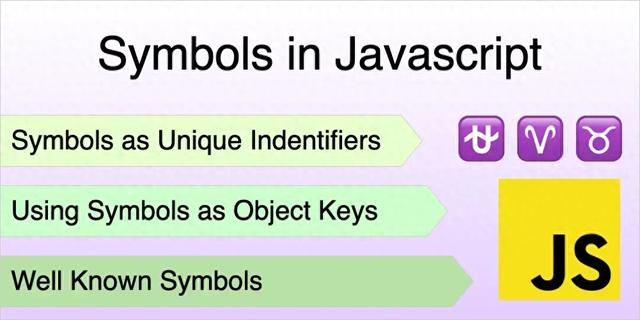大家好,很高兴又见面了,我是"高级前端进阶",由我带着大家一起关注前端前沿、深入前端底层技术,大家一起进步,也欢迎大家关注、点赞、收藏、转发!
 1.JavaScript 的 Symbols 有什么用
1.JavaScript 的 Symbols 有什么用Symbols 与其他 JavaScript 原语不同,其保证唯一性。
当开发者使用 Symbol('description') 创建 Symbols 时,其值永远不会与任何其他 Symbols 相同,即使是使用相同描述创建的 Symbols,这种独特性使其在特定用例中非常强大。
const symbol1 = Symbol('description');const symbol2 = Symbol('description');console.log(symbol1 === symbol2);// 输出 falseSymbols 的真正魅力在于对象处理,与字符串或数字不同,Symbols 可以用作属性键,而不会与现有属性发生冲突。这使其在向对象添加功能而不影响现有代码方面非常有用。
const metadata = Symbol('elementMetadata');function attachMetadata(element, data) { element[metadata] = data; return element;}const div = document.createElement('div');const divWithMetadata = attachMetadata(div, { lastUpdated: Date.now() });console.log(divWithMetadata[metadata]);// {lastUpdated: 1684244400000}同时,当使用 Symbol 作为属性键时,其不会显示在 Object.keys() 或普通 for...in 循环中。但是,开发者仍可以通过 Object.getOwnPropertySymbols() 访问这些属性。
const nameKey = Symbol('name');const person = { [nameKey]: 'Alex', city: 'London'};console.log(Object.getOwnPropertySymbols(person));// [Symbol(name)]console.log(person[nameKey]);// 输出'Alex'2.Symbol.for 创建全局 Symbol 注册表全局 Symbol 注册表为 Symbol 的使用增加了另一个维度。虽然普通的 Symbol 始终是唯一的,但有时开发者确实需要在代码的不同部分之间共享 Symbol,此时就是 Symbol.for() 的用武之地。
// 使用 Symbol.for() 在不同模块之间共享 Symbolconst PRIORITY_LEVEL = Symbol.for('priority');const PROCESS_MESSAGE = Symbol.for('processMessage');function createMessage(content, priority = 1) { const message = { content, [PRIORITY_LEVEL]: priority, [PROCESS_MESSAGE]() { return `Processing: ${this.content} (Priority: ${this[PRIORITY_LEVEL]})`; } }; return message;}function processMessage(message) { if (message[PROCESS_MESSAGE]) { return message[PROCESS_MESSAGE](); } throw new Error('Invalid message format');}const msg = createMessage('Hello World', 2);console.log(processMessage(msg));// 输出 "Processing: Hello World (Priority: 2)"console.log(Symbol.for('processMessage') === PROCESS_MESSAGE);// 输出 true// 常规 Symbols 永远不相等console.log(Symbol('processMessage') === Symbol('processMessage')); // falseSymbol.for 可以保证多次调用返回的值完全相同,因此也经常用于多个模块之间的内容共享。
// 模块 A 的内容const SHARED_KEY = Symbol.for('app.sharedKey');const moduleA = { [SHARED_KEY]: 'secret value'};// 模块 B 的内容,且在不同的文件中const sameKey = Symbol.for('app.sharedKey');console.log(SHARED_KEY === sameKey);// 输出 trueconsole.log(moduleA[sameKey]);// 输出'secret value'// 常规 Symbols 多次调用永远不同‘const regularSymbol = Symbol('regular');const anotherRegular = Symbol('regular');console.log(regularSymbol === anotherRegular); // falseSymbol.for() 创建的 Symbol 的作用类似于共享密钥,应用程序可以通过相同的名称共享。而常规 Symbol 始终唯一,即使具有相同的名称。
3. 使用 Symbols 修改 JavaScript 内置行为JavaScript 提供了众多内置 Symbol 让开发者修改对象在不同情况下的行为方式,相当于语言功能的各种钩子。
一个常见的用例是使用 Symbol.iterator 使对象可迭代,从而可以对对象使用 for...of 循环:
// 添加 Symbol.iterator 让对象可迭代const tasks = { items: ['write code', 'review PR', 'fix bugs'], [Symbol.iterator]() { let index = 0; return { next: () => { if (index < this.items.length) { return {value: this.items[index++], done: false }; } return {value: undefined, done: true}; } }; }};for (let task of tasks) { console.log(task); // 输出值'write code', 'review PR', 'fix bugs'}另一个强大的功能是 Symbol.toPrimitive,其用于控制对象如何转换为数字或字符串等原始值。
const user = { name: 'Alex', score: 42, [Symbol.toPrimitive](hint) { // JavaScript 引擎使用 hint 参数表示类型 // hint 可以是'number', 'string', or 'default' switch (hint) { case 'number': return this.score; case 'string': return this.name; default: return `${this.name} (${this.score})`; // 其他例如 user + '' } }};console.log(+user);// + 操作符表示想要数字,输出 42console.log(`${user}`);// 模板字符串表示需要字符串, 输出 "Alex"console.log(user + '');// `+ 字符串 ` 表示 "Alex (42)"当然,开发者还可以通过 Symbol.hasInstance 修改 instanceof 的默认行为,比如下面的 JSONArray 对象:
class JSONArray { constructor() { this.items = []; } // 自定义 instanceof 行为 static [Symbol.hasInstance](instance) { return instance && typeof instance === "object" && "items" in instance; }}此时,下面代码的 instanceof 将直接输出 true:
const a = {items:[]}a instanceof JSONArray// 输出 true5. 使用 Symbol.species 进行继承控制在 JavaScript 中使用数组时有时需要限制可以保存的值类型,这时就需要使用专用数组,不过值得注意的是其可能导致 map() 和 filter() 等方法出现意外行为。
const createNumberArray = (...numbers) => { const array = [...numbers]; array.push = function(item) { if (typeof item !== 'number') { throw new Error('Only numbers allowed'); } return Array.prototype.push.call(this, item); }; // 告诉 JavaScript 引擎使用常规数组方法,例如:map // 此时 map 派生数组不受影响 Object.defineProperty(array.constructor, Symbol.species, { get: function() { return Array;} }); return array;};const nums = createNumberArray(1, 2, 3);nums.push(4);// Works ✅nums.push('5');// Error! ❌ (as expected for nums)const doubled = nums.map(x => x * 2);doubled.push('6');// Works! ✅ (doubled is a regular array)6.Symbol 限制和陷阱在 JSON 中使用 Symbol 需要特别注意,例如:Symbol 属性在 JSON 序列化过程中将完全消失,这一点与 React 利用 Symbol 防止服务器端 JSON 漏洞非常类似。
const API_KEY = Symbol('apiKey');// 将 Symbol 用于属性 Keyconst userData = { [API_KEY]: 'abc123xyz',// Symbol 用于隐藏的 API key username: 'alex' // 常规属性};console.log(userData[API_KEY]);// 输出值: 'abc123xyz'// 序列化后 Symbol 完全丢失const savedData = JSON.stringify(userData);console.log(savedData);// 打印: {"username":"alex"}同时,Symbols 的字符串强制转换会导致另一个常见的陷阱。虽然开发者可能期望 Symbols 像其他基本类型一样工作,但它们对类型转换有严格的规则:
const label = Symbol('myLabel');// 抛出类型错误console.log(label + 'is my label');// 开发者必须显式转化为 Stringconsole.log(String(label) + 'is my label');// 输出值 "Symbol(myLabel) is my label"使用 Symbol 进行内存管理比较棘手,尤其是在使用全局 Symbol 注册表时。当没有引用时,常规 Symbol 可以被垃圾收集,但注册表 Symbol 会保留下来:
// 常规 Symbol 可以垃圾回收let regularSymbol = Symbol('temp');regularSymbol = null;// 注册表 Registry Symbol 保留Symbol.for('permanent');// 即使没用引用也会保留console.log(Symbol.for('permanent') === Symbol.for('permanent'));// 输出 true参考资料https://www.trevorlasn.com/blog/symbols-in-javascript
https://www.youtube.com/watch?v=ZfXAwr0Idl8
https://www.youtube.com/watch?v=KTls9254tuU
https://javascript.plainenglish.io/exploring-the-magic-of-javascript-mastering-symbol-manipulation-e4645738e8d0
